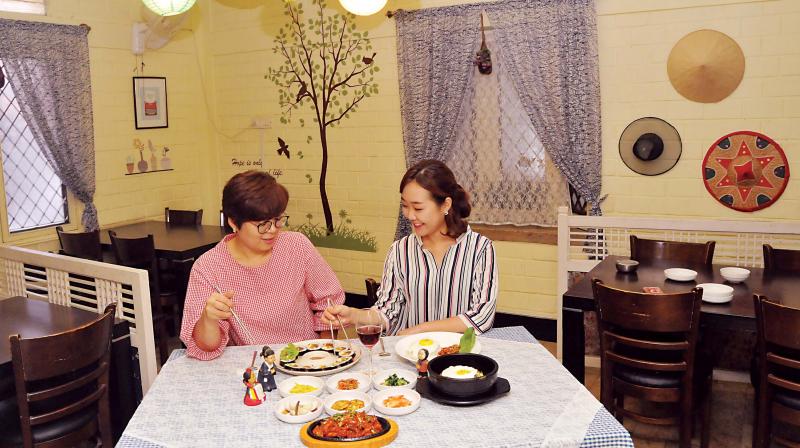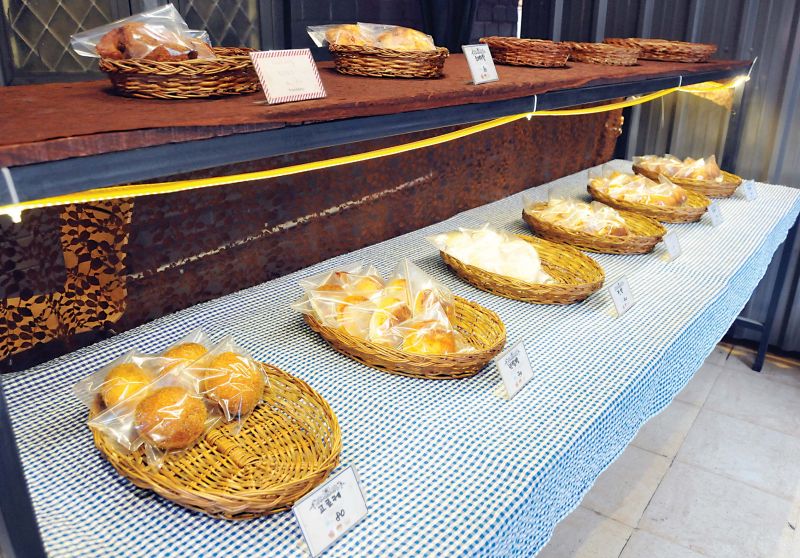Bisi Bengaluru: The BAP of all Korean

Thran
Here’s to the pretty, colourful, bowled out portions of Korean cuisine and the clanking of the steel chopsticks that aid us in our demolition of the inspired spread at this cosy mom-and-pop restaurant, Thran. Bengaluru has seen a large influx of Koreans, who come here either to study or brush up on their spoken English, so the rise of Korean cuisine isn’t too much of a surprise - South Korean Mi Jung Jung’ s Thran in Kalyan Nagar is always bustling.
Mi Jung Jung made her way to India to put her children in school here, back in 2010. And before we begin, we must go back to Kyunggi-do where the little Mi looked on curiously as her mother bustled about in the kitchen, in keeping with Korean tradition. She learnt, improvised, and became a storehouse of Korean cooking knowledge. When she came to India, after many an exploration of Indian cuisine, a far cry from the fresh fare Mi was used to, she decided to start a place of her own. Thran thew open its doors in 2012, a cosy, home-like space that served authentic Korean food, minus the frills. Two years ago, she also opened her own bakery, which offers freshly-baked Korean breads that sell like, well, hot cakes!
 Infographic
Infographic
507, Ground Floor, 4th Cross Road, HRBR Layout, 2nd Block, Kalyan Nagar
Tel: 080 4205 0685 (closed on Sundays)
Meal for two: Rs 800 onwards
Must-haves: kimbab, bulgogi and bibimbap. The soups, pancakes and stew also looked appetising.
Korean culinary history dates back to the 2000-year-old Silla dynasty. The enterprising kimchi, now the country’s most popular dish finds its place in every Korean household. There are 100 different kimchis, as it turns out, although Thran’s menu (which has pictures, thankfully, for it’s printed in Korean) goes beyond staples like kimchi, bulgogi and bibimbap.
Today, Mi has learnt and evolved and keeps changing her plethora of Korean recipes. “Thran means ‘in the garden.’ I started it to give Korean students a place to eat, and soon it became popular with locals too. I use authentic Korean ingredients and we are known for our large selection,” explains Mi Jung, the soul of this flourishing kitchen. And even though she speaks little English… it’s the food that does the talking here.
A tiny-two-roomed restaurant that was once a home, is always packed with lovers of Korean food. The staff is quick and helpful, obligingly walking perplexed newbies through the menu. The food is served promptly too – we started with the beef Kimbab, the ‘Korean sushi’ (the term doesn’t go down too well, Japanese tenets were strictly not welcome after the war). Made from Bap (rice) and Gim or Nori (sewaweed) Kimbab, fondly called the flat roll is served with a soya and sesame dip.
The pork bulgogi (fired meat) came next: batter fried pork in a spicy sauce with cabbage, onions peppers and sizzling… which we dug into with our chopsticks loving the caramelised texture and the juicy meat, which didn’t drip with fat. We ordered the bibimbap, a bowl of vegetable goodness made from spinach, cucumber, spiced onions, pulled beef slivers and topped with a fried egg - simple and delicious with Korean rice. We tucked into the banchan or side kicks —baby corn, pokchoy, bean sprouts, cucumber, steamed egg in soy and kimchi, which Mi informed us keeps changing everyday. Kimchi, it must be said, is an acquired taste, albeit one that many swear by.
The Koreans place eating as an important event, and each meal comes with bowls and bowls of different pickled vegetables, dishes, and an army of flavours with fresh ingredients. We also tried the egg soup, which was clear, stocky and light.
The banchan we loved was the spiced cucumber and pok choy … which we ate with our jeotggarak (steel chopsticks). The meal was sumptuous and fresh and we spotted Korean pancakes, beef soups, egg bakes that we will try next.
Mi Jung gets many ingredients from Korea. “It is the reason you’ll find our restaurant doing well, we have many regulars. I source Gochu jang, Soya sauce, Seaweed, Ramen, Daenjang, other sauces, chilli powder and noodles etc from Korean,” she explains. The portions are quite large, and there’s a huge menu to scour through, so go with a group! Wish they would offer a few single portions as well, and some Korean desserts (only fresh fruit and Cinnamon tea available) so we’d all be chopstick happy at the be-BAP-a-lula of Korean flavours.
 Infographic
Infographic
The bakery, which Mi started two years ago, is as popular as the restaurant itself. The famed Korean buns, with fillings like red bean paste, or rice cake inside, pizza bread, sausage buns, etc steamed or cooked lightly, with different textures and taste, are some of your choices. Accounts exist of these breads originating from Japan, as far back as 1885 and carried to Korea by a missionary named Underwood. At the height of the Korean war, flour, which was part of U.S. aid, was used to make these buns and feed the throngs. You can get the Redbean steam bread, Koroke, Custard cream bread, Sausage bread, Twisted donut, Redbean bread fresh. Be warned, however, they are sold out by the end of the day.

